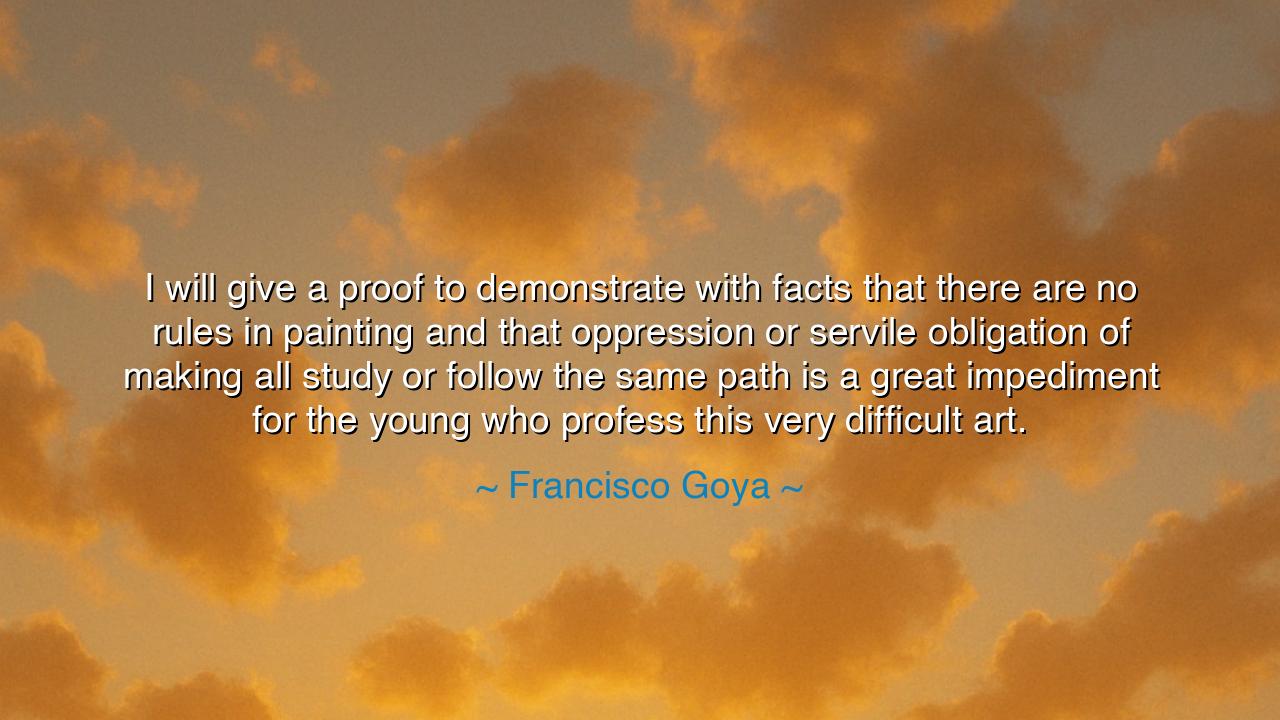
I will give a proof to demonstrate with facts that there are no
I will give a proof to demonstrate with facts that there are no rules in painting and that oppression or servile obligation of making all study or follow the same path is a great impediment for the young who profess this very difficult art.






“I will give a proof to demonstrate with facts that there are no rules in painting and that oppression or servile obligation of making all study or follow the same path is a great impediment for the young who profess this very difficult art.” — Francisco Goya
Thus spoke Francisco Goya, the defiant spirit of Spain, whose brush captured both the glory and the torment of his age. In this declaration, he shatters the chains that bind creativity, proclaiming that art must be free or it ceases to be art at all. His words are not mere rebellion — they are a cry for the soul’s liberation. For Goya knew that the artist’s task is not to imitate, but to reveal; not to conform, but to see. “There are no rules in painting,” he declares, and in doing so, he speaks for all who dare to create truth from chaos.
In the 18th century, when Goya lived and worked, the academies ruled the arts like stern monarchs. Painters were told what to paint, how to paint, and even what emotions were acceptable to express. Beauty was measured by obedience; perfection was defined by imitation. Yet Goya saw that such servile obligation strangled the fire of genius. To make every artist “follow the same path,” he warned, was to kill the divine spark within them — the very spark that gives birth to new worlds of vision. The young, whom he sought to protect, were in danger of becoming craftsmen of repetition rather than creators of truth.
Goya himself broke these rules not in words alone, but in the living proof of his art. In his youth, he painted royal portraits with precision and grace, yet even then, he slipped in hints of humanity — the fatigue behind a smile, the unease beneath the splendor. Later, as the world darkened with war and cruelty, his art turned raw and fearless. In works like The Third of May 1808, Goya cast aside convention and let emotion guide his hand. The result was not polite beauty, but terrible truth — the kind that shakes the conscience of nations. That was his proof, the demonstration by fact: art without rules breathes life; art with rules breathes only dust.
To understand Goya’s words, we must see that they reach beyond the canvas. What he speaks of painting, he speaks of all creation — and indeed of life itself. For oppression, whether in art, thought, or spirit, is the enemy of growth. The world has always sought to impose its forms upon the young — to tell them what is acceptable to dream, to think, to become. But every age of greatness has come from those who refused such bondage. When Galileo looked through his telescope and saw what others denied, he, too, broke the “rules.” When Beethoven wrote symphonies that defied every musical convention, he, too, refused to follow the same path. Goya’s cry is the cry of all who would rather walk alone than walk chained.
Yet freedom, he reminds us, is not ease. The path of the artist — or of any free soul — is difficult, as he calls it, “this very difficult art.” For to walk without rules is to walk without a map. The young must find courage to trust their own eyes, to fail without fear, and to rise without shame. They must learn not only the craft, but the conviction that their own vision has value. The difficulty is not in the painting alone, but in the strength required to remain true to oneself amid a world that demands conformity.
So let this be the lesson of Goya’s wisdom: never mistake imitation for mastery. Study the old masters, but do not become their echo. Learn the rules, yes — only so that you may later transcend them. Whether you paint, write, build, or live, your task is not to reproduce what has been done, but to reveal what has never been seen. Freedom is the essence of creation, and the courage to claim it is the mark of greatness.
Therefore, my child of the future, remember: there are no rules in painting — nor in the art of becoming fully human. Let your mind and heart be your teachers. Let your work bear the imprint of your soul, not the shadow of another’s. For only those who dare to be free — as Goya dared — can leave behind works that live beyond their time, whispering to the ages that truth and beauty cannot be commanded, only created.






AAdministratorAdministrator
Welcome, honored guests. Please leave a comment, we will respond soon